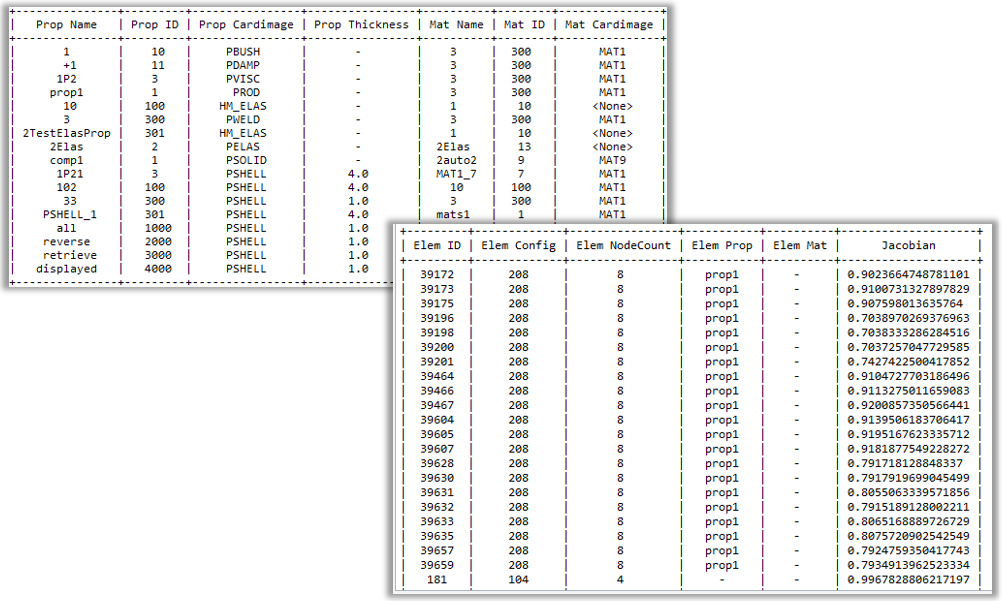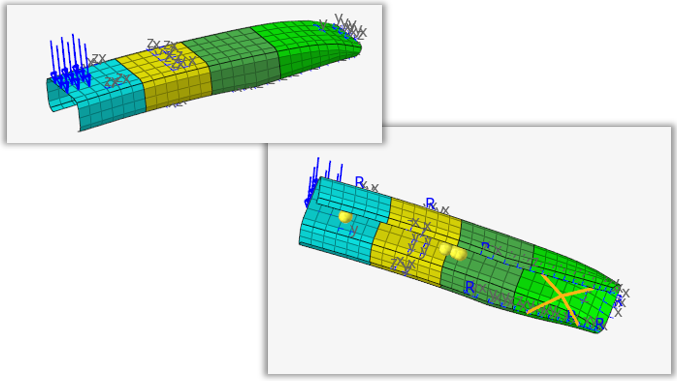Examples#
Some examples require external input files. Before you start, please follow the link in the Example Scripts section to download the zip file with model and result files.
Example 01 - Using hm and hm.entities module#
This is an example of automating a complete preprocessing task. The code consists of the following actions:
Loading the pedal.hm model.
Creating a material and assigning some properties (data names). Afterwards, a new property is created where some data names and the new material are assigned. This property is assigned to the component ID 1.
Meshing using tetramesh with element size of 0.8.
Creating a rigid link element.
Applying constraints on the independent node of newly created rigid link.
Applying pressure load on interactively selected elements.
Performing an action (rotation or translation) selected by the user via a custom GUI defined via
OptionsGuiclass.
1# ---Imports-----------
2import hm
3import hm.entities as ent
4import os
5import hwx.gui as gui
6
7class OptionsGui():
8 '''
9
10 Class for the custom GUI for selecting options for example.
11
12 '''
13 def __init__(self, model:hm.Model):
14
15 # Initialization of some attributes
16 self.option = 1 # Option
17 self.model = model #Passing Model instance to class
18 # Constructing the GUI adding option combo box and run/close buttons
19 optionLabel=gui.Label(text="Options:")
20 self.optionCombo=gui.ComboBox(((1, "Translate Elements"), (2, "Rotate Elements"),),command=self.option_selection)
21
22 closeButton = gui.Button("Close", command=self.on_close)
23 runButton = gui.Button("Run", command=self.on_run)
24
25 self.mainFrame = gui.GridFrame(
26 (optionLabel, self.optionCombo),
27 (closeButton, runButton),
28 )
29 self.dialog = gui.Dialog(caption="Export Dialog", width=230, height=150)
30 self.dialog.addChildren(self.mainFrame)
31 self.dialog.show()
32
33 def option_selection(self, event):
34 '''
35 Helping function
36 Passing to option attribute the combo box value, by changing events (i.e., options)
37 '''
38 self.option = event.value
39
40 def on_close(self):
41 '''
42 Helping function
43 Closing GUI
44 '''
45 self.dialog.Hide()
46
47 def on_run(self):
48 '''
49 Helping function
50 Running GUI functionality.
51 '''
52 print(f"Option {self.option} will run...")
53 option_runner(model=self.model, opt=self.option)
54 print(f"Option {self.option} finished!")
55 self.dialog.Hide()
56
57def main():
58
59 '''
60
61 Function for the main procedure of the example
62
63 '''
64
65 # Grabbing a model instance by name
66 session = hm.Session()
67 model = hm.Model(session.get_all_models()[0])
68
69 # Reading HyperMesh model
70 script_dir = os.path.dirname(os.path.abspath(__file__))
71 model.hm_answernext("yes")
72 model.readfile(os.path.join(script_dir,"pedal.hm"),0)
73
74 # Material Creation
75 mat1 = ent.Material(model)
76 mat1.name = "Steel"
77 mat1.cardimage = "MAT1"
78 mat1.E = 21e04
79 mat1.Nu = 0.3
80 mat1.Rho = 7850
81
82 # Property Creation and Material Assignment to Property
83 prop1 = ent.Property(model)
84 prop1.name = "Prop"
85 prop1.cardimage = "PSOLID"
86 prop1.materialid = mat1
87
88 # Assign Properties to Component with id=1
89 compID = 1
90 comp1 = ent.Component(model, compID)
91 comp1.propertyid = prop1
92
93 # Create Tetramesh
94 node_col = hm.Collection(model, ent.Node, populate=False)
95 str_array1 = hm.hwStringList(
96 [
97 "pars: upd_shell fix_comp_bdr post_cln elem_order = 2 delaunay el2comp=3 fill_void=1 tet_clps='0.100000,0.300000, 0.500000, 1.000000, 0.380000, 0.100000'",
98 "tet: 35 1.3 -1 0.014 0.8 0 0 1",
99 "2d: 1 0 4 0.01 0.001 30 1",
100 ]
101 )
102 solids_col = hm.Collection(model, ent.Solid)
103 model.tetmesh(
104 collection1=solids_col,
105 mode1=1,
106 collection2=node_col,
107 mode2=5,
108 string_array=str_array1,
109 )
110
111 # Create a rigid link element
112
113 # Independent Node for rigidlink
114 indNode = ent.Node(model, 1462)
115 # Dependent Nodes for rigidlink
116 nodelist = (
117 list(range(1420, indNode.id))
118 + list(range(indNode.id + 1, 1642))
119 + list(range(74051, 74064))
120 + list(range(74214, 74300))
121 + list(range(74356, 74369))
122 + list(range(74980, 75066))
123 )
124 filtNode = hm.FilterByEnumeration(ent.Node, nodelist)
125 depnodes = hm.Collection(model, filtNode)
126 model.rigidlink(
127 independent=indNode, collection=depnodes, dofs=123456
128 ) # rigid link creation
129
130 # Applying constraint to independent node of rigid link.
131 indNode_col = hm.Collection([indNode])
132 model.loadcreateonentity_curve(
133 collection=indNode_col,
134 config=3,
135 type=1,
136 comp1=0,
137 comp2=0,
138 comp3=0,
139 comp4=0,
140 comp5=0,
141 comp6=0,
142 x_loc=0,
143 y_loc=0,
144 z_loc=0,
145 curve_id=0,
146 x_scale=0,
147 )
148
149 # Creating a Load collection with the name "Pressure" and we apply it on selected elements
150 loadcol2 = ent.Loadcol(model)
151 loadcol2.name = "Pressure"
152
153 elemes = hm.CollectionByInteractiveSelection(model, ent.Element)
154 filt = hm.FilterByCollection(ent.Node, ent.Element)
155 nele = hm.Collection(model, filt, elemes)
156
157 model.pressuresonentity_curve(
158 collection=elemes,
159 facenodes=nele,
160 x_comp=0,
161 y_comp=0,
162 z_comp=-1,
163 magnitude=1,
164 breakangle=30,
165 onface=1,
166 xlocation=0,
167 ylocation=0,
168 zlocation=0,
169 curve_id=0,
170 x_scale=0,
171 )
172
173 # Setting up the loadstep
174 loadStep1 = ent.Loadstep(model)
175 loadStep1.OS_TYPE = 1 # Linear Static
176 loadStep1.OS_SPCID = model.get(hm.Entity(ent.Loadcol, 1))
177 loadStep1.OS_LOADID = loadcol2
178
179 # Two options for our geometry. Translation or rotation of elements. Selected and run via GUI
180 OptionsGui(model)
181
182def option_runner(model:hm.Model, opt:int):
183 if opt == 1:
184 # Translate elements
185 tranElem = hm.CollectionByInteractiveSelection(model, ent.Element)
186 model.translatemark(collection=tranElem, vector=[0.0, 1.0, 0.0], distance=0.5)
187 elif opt == 2:
188 # Rotate component
189 comp1 = hm.Collection(model, ent.Component, [1])
190 RotAx = [0.0, 0.0, 1.0]
191 PlaneOr = [0.0, 0.0, 0.0]
192 model.rotatemark(
193 collection=comp1, plane_normal=RotAx, plane_base=PlaneOr, angle=30
194 )
195
196if __name__ == "__main__":
197 main()
Example 02 - Querying entity attributes#
The first part of the code creates a collection of all properties and queries their attributes, including the attributes of the assigned material. The data is stored in prop_data list and printed in the console using the prettytable library.
In the second part, the code prompts the user to interactively select some elements. It then loops through the returned collection and extracts various elements attributes. It stores the data in the elem_data list and prints it in the console using the prettytable library.
1import hm
2import hm.entities as ent
3import prettytable as pt
4
5model = hm.Model()
6
7# Create a collection of all properties in the model
8prop_data = list()
9props = hm.Collection(model, ent.Property)
10
11# Printing a table of properties and their respective material if exist
12for p in props:
13 prop_name = p.name
14 prop_id = p.id
15 prop_cardimage = p.cardimage
16 if prop_cardimage == "PSHELL":
17 prop_thickness = p.PSHELL_T
18 else:
19 prop_thickness = "-"
20 if p.materialid:
21 mat = p.materialid
22 mat_name = mat.name
23 mat_id = mat.id
24 mat_cardimage = mat.cardimage
25 else:
26 mat_name = "-"
27 mat_id = "-"
28 mat_cardimage = "-"
29 prop_data.append(
30 [
31 prop_name,
32 prop_id,
33 prop_cardimage,
34 prop_thickness,
35 mat_name,
36 mat_id,
37 mat_cardimage,
38 ]
39 )
40
41tab = pt.PrettyTable(
42 [
43 "Prop Name",
44 "Prop ID",
45 "Prop Cardimage",
46 "Prop Thickness",
47 "Mat Name",
48 "Mat ID",
49 "Mat Cardimage",
50 ]
51)
52
53tab.add_rows(prop_data)
54print(tab)
55
56# Create a collection of elements by interactive selection
57elems = hm.CollectionByInteractiveSelection(model, ent.Element)
58
59# Create a table of elements along with following attributes: id, configuration number, property name, material name, number of nodes, and jacobian.
60elem_data = list()
61
62for e in elems:
63 el_id = e.id
64 el_conf = e.config
65 el_ncount = e.nodecount
66 if e.propertyid:
67 el_prop_name = e.propertyid.name
68 else:
69 el_prop_name = "-"
70 if e.materialid:
71 el_mat_name = e.materialid.name
72 else:
73 el_mat_name = "-"
74 if e.jacobian:
75 el_jac = e.jacobian
76 else:
77 el_jac = "-"
78 elem_data.append(
79 [
80 el_id,
81 el_conf,
82 el_ncount,
83 el_prop_name,
84 el_mat_name,
85 el_jac
86 ]
87)
88
89tab2 = pt.PrettyTable(
90 [
91 "Elem ID",
92 "Elem Config",
93 "Elem NodeCount",
94 "Elem Prop",
95 "Elem Mat",
96 "Jacobian",
97 ]
98)
99tab2.add_rows(elem_data)
100print(tab2)

Figure 1. Querying elements’ and properties’ data
Example 03 - Creating a node at CoG of every component#
The code imports the HyperMesh bumper.hm model, creates and defines a new material entity, and then assigns it to a newly created property entity. A collection of all components is then created and the code loops over the components in the collection to perform the following actions on each component:
assigning the property to the component
calculating the CoG (Center of Gravity) of the component
creating a new node and positioning it at the CoG location
1import hm
2import hm.entities as ent
3
4model = hm.Model()
5
6# Importing the model in HyperMesh
7datadir = rf"{hm.altair_home}\demos\hm"
8model.hm_answernext("yes")
9model.readfile(
10 filename=os.path.join(datadir, "bumper.hm"),
11 load_cad_geometry_as_graphics=0,
12)
13
14# Create a material with name 'Al' and properties of Aluminum
15mat1 = ent.Material(model)
16mat1.name = "Al"
17mat1.cardimage = "MAT1"
18mat1.E = 7e04
19mat1.Nu = 0.3
20mat1.Rho = 2700
21
22# Create a property with the name 'central_prop' and assign 'Al' material to it
23prop1 = ent.Property(model)
24prop1.name = "central_prop"
25prop1.cardimage = "PSHELL"
26prop1.materialid = mat1
27prop1.PSHELL_T = 1.0
28
29# Create a collection of all components
30comp_col = hm.Collection(
31 model, ent.Component
32)
33
34# Assign the property to all components, compute for each component the center of gravity (CoG) and a create a node to cog
35for comp in comp_col:
36 comp.propertyid = prop1
37 ccol = hm.Collection(model, ent.Component, [comp.id])
38 status, result = model.hm_getcog(ccol)
39 nodeNew = ent.Node(model) # Create a new node
40 nodeNew.localcoordinates = result.coord # Place the node at CoG

Figure 2. Creating nodes at components COGs
Example 04 - Creating a new component per solid (includes “performance” API)#
The example shows how to organize each solid entity in the model into individual component using the HyperMesh movemark() function. The code also includes a custom performance() function which is used before and after the loop to turn on/off certain functionalities to speed up the process. Before entering the for loop, the function disables the graphics refreshing, writing into the command file, entity highlighting, and browser update. After the loop, the functionalities are reenabled.
1import hm
2import hm.entities as ent
3
4
5def main():
6
7 model = hm.Model()
8
9 solidcol = hm.Collection(model, ent.Solid)
10
11 # Enable performance boost
12 performance(model, True)
13
14 # Create a component for each solid
15 for solid in solidcol:
16 comp = ent.Component(model)
17 comp.name = f"solid_{solid.id}"
18 # Organize (move) the solid to the new component
19 solid_in_col = hm.Collection([solid])
20 model.movemark(collection=solid_in_col, name=f"solid_{solid.id}")
21
22 # Disable performance boost
23 performance(model, False)
24
25
26def performance(model, switch):
27 if switch == True:
28 hm.setoption(
29 block_redraw=1,
30 command_file_state=0,
31 entity_highlighting=0,
32 )
33 model.hm_blockbrowserupdate(mode=1)
34 else:
35 hm.setoption(
36 block_redraw=0,
37 command_file_state=1,
38 entity_highlighting=1,
39 )
40 model.hm_blockbrowserupdate(mode=0)
41
42
43if __name__ == "__main__":
44 main()